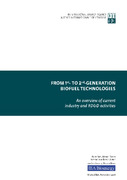| dc.description.abstract | It is increasingly understood that 1 st-generation biofuels (produced primarily from food crops such
as grains, sugar beet and oil seeds) are limited in their ability to achieve targets for oil-product
substitution, climate change mitigation, and economic growth. Their sustainable production is
under review, as is the possibility of creating undue competition for land and water used for food
and fibre production. A possible exception that appears to meet many of the acceptable criteria is
ethanol produced from sugar cane.
The cumulative impacts of these concerns have increased the interest in developing biofuels
produced from non-food biomass. Feedstocks from ligno-cellulosic materials include cereal straw,
bagasse, forest residues, and purpose-grown energy crops such as vegetative grasses and short
rotation forests. These “2nd-generation biofuels” could avoid many of the concerns facing 1stgeneration biofuels and potentially offer greater cost reduction potential in the longer term.
This report looks at the technical challenges facing 2nd-generation biofuels, evaluates their costs
and examines related current policies to support their development and deployment. The potential
for production of more advanced biofuels is also discussed. Although significant progress continues
to be made to overcome the technical and economic challenges, 2nd-generation biofuels still face
major constraints to their commercial deployment. Policy recommendations are given as to how
these constraints might best be overcome in the future. | en_US |

